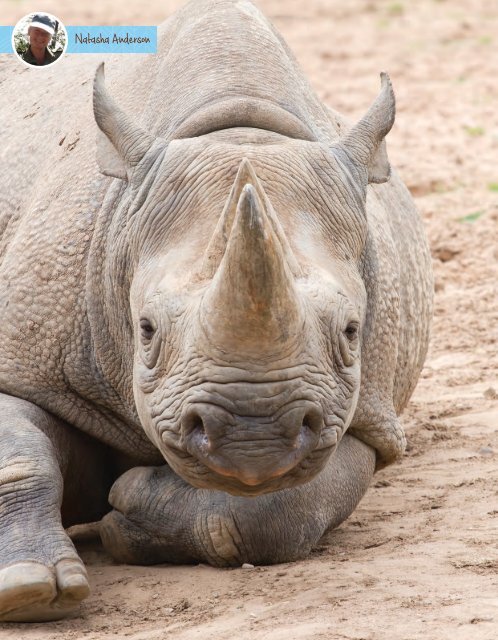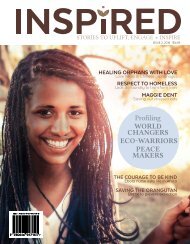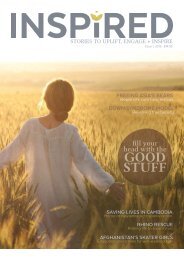Inspired - Full issue
Feature stories to uplift, engage and inspire
Feature stories to uplift, engage and inspire
You also want an ePaper? Increase the reach of your titles
YUMPU automatically turns print PDFs into web optimized ePapers that Google loves.
Natasha Anderson<br />
Fighting for a cause you believe in is one thing but<br />
risking your life to do so is quite another. What drives<br />
this Australian woman to risk her life to save rhinos amid<br />
achingly beautiful Zimbabwean bush?<br />
It was August 2008 and Natasha Anderson received<br />
a call from the field. Poachers had shot a mother<br />
black rhino in the shoulder. The rhino was injured<br />
but likely to survive. She had a two-month-old calf<br />
at foot.<br />
Natasha and her team leapt into land cruisers and<br />
sped to the site. They captured the duo and put them<br />
in pens. While not mortally wounded, the mother<br />
wasn’t producing enough milk to sustain her calf. So<br />
Natasha embarked on a mission to save him. For 10<br />
to 12 hours a day she’d sit just outside their enclosure<br />
wooing and attempting to bottle-feed the infant.<br />
As if sensing that Natasha was trying to help, the<br />
mother rhino, Teressa, positioned her enormous form<br />
in a way that forced the calf towards Natasha and<br />
the bottle. The hungry calf, reassured by his mother,<br />
took to the bottle and regained strength. Over three<br />
weeks Teressa’s wound healed and the duo was<br />
returned to freedom in the vast African bush.<br />
Natasha watched the calf grow over the years like<br />
a proud mother herself. She delighted in seeing new<br />
offspring Teressa produced. Here was a good news<br />
story in the intense battle to save black rhinos from<br />
the poaching menace that is threatening their very<br />
survival.<br />
Today only 5000 black rhinos remain, their<br />
populations decimated to provide horn as status<br />
symbols, herbal medicine, even hangover cures,<br />
especially in Vietnam and China. Natasha and the<br />
team at Lowveld Rhino Trust are endangering their<br />
own lives to save the rhinos, dodging bullets in gun<br />
battles with machine-gun wielding poachers, dealing<br />
with enormous and incredibly agile wild animals and<br />
operating under challenging political and economic<br />
circumstances.<br />
So how is it that an Aussie lass from Melbourne finds<br />
herself in shootouts in the Zimbabwean bush for the<br />
sake of a wild African animal?<br />
FALLING IN LOVE<br />
Natasha was fresh out of university when she<br />
applied to join Australian Volunteers Abroad in Africa.<br />
She ventured to Zimbabwe to work with communities<br />
on resource and catchment management programs.<br />
However, given the volatile politics in the early 2000s,<br />
Natasha’s work in the rural communities became too<br />
dangerous to continue.<br />
While friends from the villages risked their own lives<br />
to warn Natasha of planned youth militia attacks,<br />
she knew she had to be careful. She had to avoid<br />
taking the same approach and exit routes to reduce<br />
the chance of being attacked. At the same time,<br />
funding support for her projects dried up.<br />
As her opportunity to work on community<br />
development declined, a new need arose – helping to<br />
monitor critically endangered black rhinos helplessly<br />
caught in the politics of the time. New clearing of<br />
land for subsistence farming spread through roughly<br />
Above Poachers hack<br />
off only the horn from a<br />
rhino’s face, leaving the<br />
rest of the body behind.<br />
Opposite page Only<br />
5000 black rhinos<br />
survive today, their<br />
populations decimated<br />
by poachers.<br />
NATASHA ANDERSON 19












